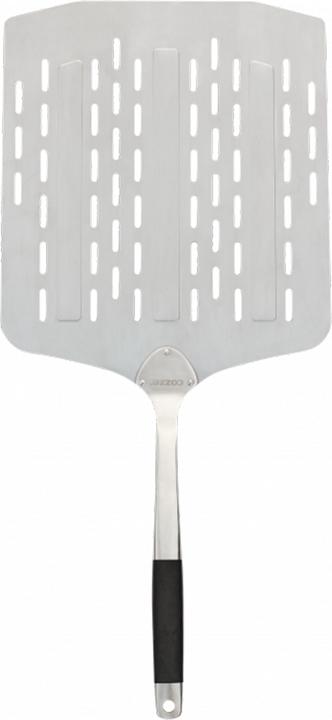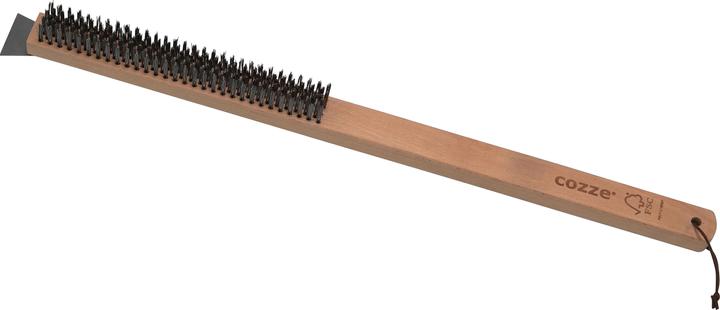
Cozze oven review: delicious pizza from a hot mussel
You like pizza the Italian way – fast, hot and crispy? Then check out the Cozze pizza oven. It delivers high heat without needing gas or wood pellets.
For English subtitles, click the gear icon, «Subtitles/CC» and «Auto-translate».
What do you need to bake a good pizza? Heat. Lots of it. At least 400 degrees is required to turn the dough patty into a crispy pizza. A regular oven can’t deliver that. Most models reach only 250, few manage 280 degrees. This is enough to bake a frozen pizza, but not that ultimate Italian-style crispy pizza.
If you love pizza the way you get it in Naples or New York, you need a «real» oven. Since the spring of 2020, pizza ovens for home use are booming – thanks to Ooni, among others. Founded by a Finnish woman in 2013, the brand is riding on a wave of success. Ooni ovens are bestsellers on Galaxus, too. Over the years, other manufacturers have launched ovens in the hope of getting their slice of the pizza pie. The Danish manufacturer Cozze, for instance, has come up with a pizza oven that costs not even half as much as the one by Ooni. So, does the cheap Dane, who’s chosen the Italian word for mussel as its brand name, bake a good pizza? Let’s find out.
Together with our culinary expert Simon Balissat, I decide to put the Cozze pizza oven to the test. To be more precise, I’m testing the electric model. There’s no need for a gas bottle or wood pellets. The Cozze oven turns the 2,200 watts it draws from the wall socket into over 400 degrees of heat. That’s what we need to bake a good pizza. A good start, in theory.
We’re testing the large 17-inch model. According to the instructions, it’s designed for outdoor use, so it’s not allowed to be used in the kitchen. I heave the box onto the terrace and set it up. The oven alone weighs just over 20 kilogrammes. The housing is made of sheet steel that’s been tightly screwed together and hot-dip galvanised. The appliance is 60 centimetres wide, 60 centimetres deep and 30 centimetres high, including the small feet. They’re high enough that I can safely place the oven on a wooden table. There are a good ten centimetres between the tabletop and the oven, so the heat leaves no traces. The door is the only part I have to assemble before I can start baking pizzas. Having said that, there’s not much assembling to be done. I only need to screw the handle onto a piece of sheet metal. The matching Torx screwdriver and wrench aren’t supplied. The door is no more a door than Adam’s fig leaf is a pair of underpants.

Source: Manuel Wenk
The Danish manufacturer is quite stingy when it comes to the scope of delivery. In addition to tools, you’ll also need a pizza shovel before your career as a pizzaiolo can begin. I’d also recommend getting a wire brush to clean the pizza stone.
At least the pizza stone is included in the delivery. It’s a1-centimetre-thick square slab of cordierite with 42-centimetre-long sides. That’s rather thin – this stone won’t be able to store heat for very long.
Heating up
Once the stone is in the oven, I attach the door. More specifically, I tuck the sheet metal cover under the stone so that it stays in place. Then it’s time to heat up the oven. The Cozze pizza oven has a control dial with a digital temperature display. That’s simple, but all I need. I like how easy it is to use. I set the target temperature – 400 degrees – and take a look inside the oven. Above the pizza stone, the exposed heating coils slowly turn red. The temperature display lets you know how hot the baking surface currently is. At least that’s what the instructions say.

Source: Manuel Wenk
In our test, the pizza stone reached the target temperature of 400 degrees – measured with an infrared thermometer – after about 25 minutes. The digital display indicated it a few minutes earlier. It’s a bit hotter in the rear than in the front, which is due to the somewhat too air-permeable flap. In theory, this oven could reach up to 450 degrees.

Source: Manuel Wenk
Ready for pizza
For our test, Simon prepared two types of pizza dough and let each rise for 48 hours. One’s a classic Neapolitan pizza (here’s the recipe) and the other’s a New York-style pizza (here’s the recipe). New York-style pizza dough is a bit flatter and stays in the oven at a low temperature a few minutes longer than the original dough from Italy.
If you don’t trust Simon’s recipe, you can also go with the classic pizza dough recipe that’s included in the Cozze instructions. It's similar to Simon’s, only with much shorter proofing time. It says to let the dough rise for 4 hours – Simon finds this incredibly little.
Topped with some tomato sauce – we use Mutti’s – and mozzarella, the Italian pizza goes into the oven first. It slides onto the hot stone on the pizza paddle that’s dusted with semolina. The opening is nice and high – 8.5 centimetres. This makes it easy to check the baking progress. Not that it takes long. In fact, we turn the pizza after two minutes, so that the other side gets the highest temperature, too, and after another minute, the margarita is ready. It has a crispy base and very light black dots on the bottom where the dough touches the pizza stone. The New York-style pizza, which Simon calls «flappy», also comes out as desired.

Source: Manuel Wenk

Source: Manuel Wenk
Verdict
The Cozze electric pizza oven has three advantages:
- It’s electric.
- It bakes great pizza.
- It’s quite affordable.
Even though Simon addresses the high power consumption in the video, overall, an electric oven is the most efficient way to make homemade pizza. It’s the most climate-friendly way, too, especially if the electricity is generated with hydropower or solar cells. An oven also uses 2,200 watts, but it doesn’t get as hot as the Cozze pizza oven.
However, these Cozze pizza oven also has three disadvantages:
- You can only use it outside.
- It takes up quite some space.
- You have to buy the accessories separately.
The Cozze is quite bulky, especially the 17-inch version. You're unlikely to set it up – or free it from the cover – for a quick pizza lunch. But you’ll have almost nothing to prepare, as all you need to do is plug it in, set the temperature and wait. That’s it.
What’s a big disadvantage for me is that I’m only allowed to use the Cozze – even the small one – outside. That’s usually no problem in spring and summer, but what if I’m in the mood for pizza on a stormy autumn day? Maybe I’ll wait until Ooni launches a small electric pizza oven that’s also suitable for indoor use. Or I’ll get the Sage, which Simon has already tested.
Journalist since 1997. Stopovers in Franconia (or the Franken region), Lake Constance, Obwalden, Nidwalden and Zurich. Father since 2014. Expert in editorial organisation and motivation. Focus on sustainability, home office tools, beautiful things for the home, creative toys and sports equipment.





